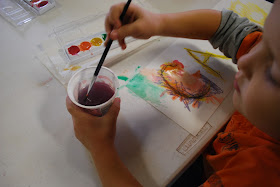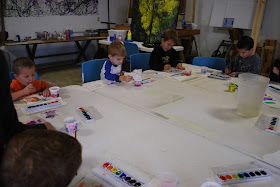 |
| front cover to our book |
We made fantastic books in preschool art. They are so easy to make and can be used to keep art work, hold a story sequence, or photos, etc. And if you start from the back you have a second set of blank pocketless pages to write or draw a story! I will show you what I mean below.
So here are some photos to show you how easy it is to fold this book.
I wanted the books to be a few pages longer so I simply bound two folded books together as shown above.
This book is awesome to hold loose art work and can also stand up for easy art portfolio display.
Now that we folded our books we need to make a front and back cover for them to show just how creative we are! We started with the front cover. I had the kids do a collage with maps in the back ground. Then they wrote the first letter of their first name in permanent ink on top of the collage. This ties us back to our Alphabet adventures of the last couple of weeks as well.
Next they colored with crayons... the more crayons, the more colors, the more beautiful! Finally we painted over the whole thing with a wash of watercolor.
We had to make a back cover too so we tried something completely different for this! This was really fun and I have a feeling the kids could have done this for a lot longer. We will have to do it again on bigger paper and outside when it is warmer....
We
SPRAY PAINTED!
So, we started by placing a piece cut to the size of our cover in a box to contain the spray of the paint. Next we added a die cut letter. I put tempera paint mixed with water into spray bottles and the kids sprayed two colors over their letter.
Here are the results! the die cut letters left an image where the paint was blocked AND we ended up with cool painted letters as well!
While we waited for our paint to dry the kids started working in their books. You can decorate the pockets, tell a story on the pockets, design the background behind where your art will be, AND turn the whole thing over to have blank pages for a new story or art work.
 |
| pocket side |
 |
| story side |
























































